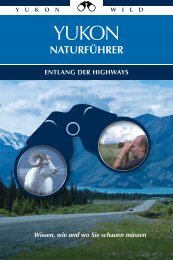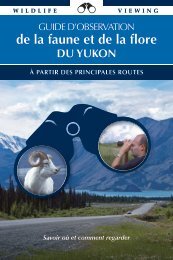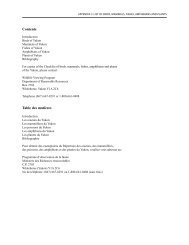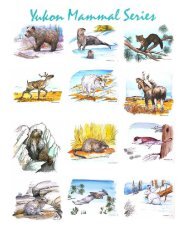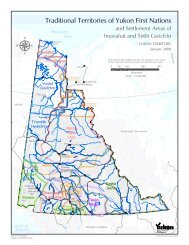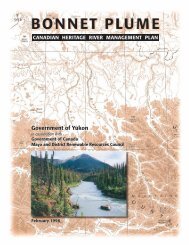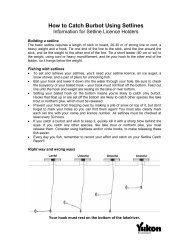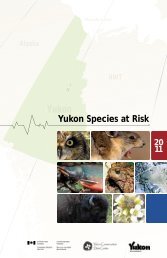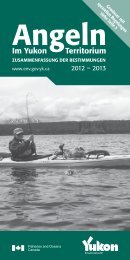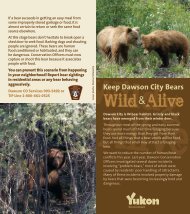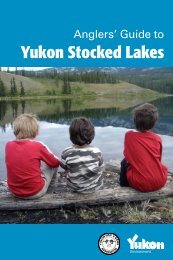Ch. 3 Land - Environment Yukon
Ch. 3 Land - Environment Yukon
Ch. 3 Land - Environment Yukon
Create successful ePaper yourself
Turn your PDF publications into a flip-book with our unique Google optimized e-Paper software.
government has formed a partnership<br />
with First Nations and together the parties<br />
are pursuing the development of a<br />
common oil and gas regime. Under<br />
this common framework of legislation,<br />
regulations and policies there will be<br />
one set of rules for exploration and<br />
development. The core component of<br />
the common regime–the <strong>Yukon</strong> Oil and<br />
Gas Act–was enacted in 1998. A number<br />
of the key regulations have been<br />
developed and others are being developed.<br />
The existing regulations apply to<br />
the exploration stage and are regarded<br />
as very strict. They contain provisions<br />
that are not covered in other jurisdictions.<br />
For example, financial deposits<br />
are required to guarantee that abandonment<br />
and clean-up of wells will be<br />
conducted properly.<br />
As conventional supplies of oil and gas<br />
dwindle in Western Canada and<br />
companies seek alternative sources,<br />
exploration in the north becomes more<br />
favourable. <strong>Yukon</strong> is situated at the<br />
Figure 3.7 Oil and Gas Potential in the <strong>Yukon</strong><br />
<strong>Yukon</strong> contains eight sedimentary basins with potential to host oil and gas deposits. Each<br />
basin has its own unique geological history and character. Seventy-one wells have<br />
been drilled in the <strong>Yukon</strong> and most of these are located in the Liard Plateau, Peel Plateau,<br />
and Eagle Plain basins. The remaining five basins–Bonnet Plume, Kandik, Old Crow,<br />
Whitehorse Trough, and Coastal Plain–are virtually unexplored. There is also considerable<br />
oil and gas potential in the Beaufort Sea off the <strong>Yukon</strong>’s north coast.<br />
periphery of oil and gas producing<br />
regions with Alberta and British<br />
Columbia to the south, the Northwest<br />
Territories to the east, and Alaska to<br />
the west. Activity and infrastructure in<br />
Alberta and British Columbia extend<br />
into the southeast <strong>Yukon</strong> and<br />
opportunities exist for it to move<br />
northward.<br />
Current exploration interest is largely<br />
focused on the Liard Plateau in the<br />
southeast corner of the <strong>Yukon</strong> where<br />
one producing field is located. The best<br />
prospects are expected to be large<br />
deep gas pools similar to the producing<br />
field at Kotaneelee. There is also interest<br />
in Eagle Plains in north central <strong>Yukon</strong><br />
and a company is currently planning to<br />
produce crude oil from proven oil and<br />
gas reserves here for sale in the local<br />
<strong>Yukon</strong> market.<br />
In the past, seismic cutlines were six to<br />
eight metres wide which caused forest<br />
fragmentation and created access into<br />
otherwise remote areas. Through the<br />
assessment process, industry and the<br />
regulators are seeking to reduce access<br />
into the exploration areas. Technology<br />
has also evolved to significantly reduce<br />
access to and within exploration areas.<br />
Now cutlines are a maximum width of<br />
1.5 meters, and trees are limbed and<br />
not entirely cut down. A team walks<br />
along the line and cuts an opening<br />
where a helicopter lowers the drill to<br />
conduct the seismic work. The drill is<br />
removed and lowered to another<br />
specified location further down the<br />
line. This method of exploring for oil<br />
and gas is far more environmentally<br />
friendly than previous methods.<br />
The oil and gas industry is still in the<br />
exploration stages in the <strong>Yukon</strong>. With<br />
more producing wells coming on<br />
stream, there is the potential for<br />
emissions of carbon dioxide and<br />
sulphur dioxide to increase, contributing<br />
to global warming and acid rain.<br />
Industry and governments are currently<br />
addressing this problem 1.<br />
4 2 ❧ Y U K O N S T A T E O F T H E E N V I R O N M E N T R E P O R T 1999





